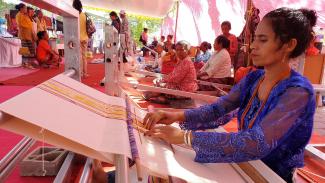DILI, December 15, 2021—Timor-Leste is celebrating an important cultural milestone. The United Nations Educational, Scientific and Cultural Organization (UNESCO) has announced that the country’s application for the inscription of its hand-woven traditional textile, known locally as Tais, as an “Intangible Cultural Heritage in Need of Urgent Safeguarding” has been successful.
Tais is now listed alongside renowned cultural assets from other countries, such as traditional hand puppetry in Egypt, the bisalhães black pottery manufacturing process in Portugal, and the ancient art of hand-crafting “phinisi boats in Indonesia. The listing has opened the way to the allocation of a nearly $270,000 grant from the Intangible Cultural Heritage Fund for the implementation of a safeguarding plan for Tais. The Timor-Leste government and development partners will also fund the initiative.
The project is expected to raise public awareness about Tais, motivate youth to take an interest in Tais and learn the weaving techniques, increase income opportunities for weavers, attract tourists’ interest in Tais as part of Timor-Leste’s culture, and strengthen weavers’ networks.
“We would like to congratulate Timor-Leste on achieving this significant milestone,” said USAID Mission Director Zema Semunegus. “UNESCO recognition validates the cultural importance of Tais to Timor-Leste and the valuable contribution of the women who create this beautiful textile. It will help to support family livelihoods throughout the country for generations to come and also enhance the cultural tourism offering.”
The UNESCO application conditions are stringent and preparation of the documentation started in January 2019. USAID’s Tourism For All Project provided support to help Timorese authorities and stakeholders, starting with the creation of a National Committee for Intangible Cultural Heritage (IHC) to coordinate the application procedure. One of the primary UNESCO requirements is the close involvement of the various stakeholders—ranging from Government representatives to national NGOs and community weaving groups—to ensure a full consensus supporting the application. This was achieved through consultations at a forum organized by USAID, “Protecting, Preserving, and Promoting Tais: the Road towards UNESCO’s Intangible Cultural Heritage Recognition.” The final step in the application process was the production of a short film required by UNESCO, to describe the significance of Tais and the traditional spinning, dyeing and weaving skills used to make it.
More than 100 people from local and international organizations, development partners and Tais weavers contributed to drawing up the safeguarding plan. This three-year initiative will be implemented by IHC. Activities will include promoting Tais in fairs, creating a television programme and adding Timor-Leste’s cultural elements, including Tais, to school curricula. The project will also conduct field research and document and photograph the raw materials used and the Tais products in the communities and local markets. The results of this research will be used to develop a permanent exhibition, which will also include live demonstrations by weavers. Schoolteachers will then receive training on the content of the exhibition and be encouraged to bring their students to the exhibition. Other project activities include creating a Tais weaving competition for youth, providing training on cotton cultivation and natural dyeing, supporting weavers’ management skills and livelihoods through training, and a formal certification system.
“We really appreciate the contribution of the American people in achieving the UNESCO nomination,” said Secretary of State for Art and Culture of Timor-Leste, Teofilo Caldas. “USAID’s Tourism For All Project‘s involvement was important and necessary in assisting the government with drawing up the safeguarding plan. We will still need their support in developing school curriculum content and technical assistance with Tais certification.”.
Tais plays an important role in the life of Timorese people. The textile is used for decoration and to create traditional clothing with specific styles for men and women. People use Tais to welcome new-borns as well as for weddings, traditional ceremonies, and festivals. Made from cotton dyed with natural plants, Tais is traditionally handwoven using simple equipment. The production process, however, is quite complex and time-consuming and entails preparing and dyeing the cotton before weaving the material. Although men may participate in the process by gathering plants to dye the cotton and making the equipment, the production of Tais is a role reserved for women, who are also responsible for passing the knowledge and skills on to the next generation.
Local NGO Timor Aid has been working with Tais weavers for more than two decades, and the organization was represented on the National Intangible Cultural Heritage committee. Timor Aid co-founder Maria do Ceu Lopes da Silva said: “We are bursting with pride to see our long-term dream turn into reality. Ultimately the real winners of the UNESCO listing are the Timor-Leste weavers. Tais remains a viable economic empowerment for rural women. I hope that the UNESCO pronouncement will strengthen the support for the Timor-Leste weavers, especially in the area of preservation.”
The UNESCO listing recommends that the Government monitors and mitigates any unintended consequences arising from over-tourism and over-commercialization and to seek a balance between the economic and the social and cultural functions of Tais. Tais is one of the “must have” souvenirs bought by tourists, a vital market for local weavers. It also inspires the fledgling fashion industry in Timor-Leste, presenting a commercial opportunity, but also a threat to the integrity of Tais culture. The UNESCO project’s focus on youth will help to protect the cultural tradition of Tais in the long term.

